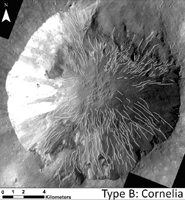- Original Caption Released with Image:
-

Annotated Image
Click on the image for larger versionThis image shows examples of long, narrow, sinuous gullies that scientists on NASA's Dawn mission have found on the giant asteroid Vesta. The crater shown here is called Cornelia. The gullies in Cornelia -- called "Type-B" gullies -- are different from the straighter, wider, shorter gullies that scientists have designated as "Type-A" gullies. Scientists think these two gully types have different formation mechanisms. This image was obtained by Dawn's framing camera on Jan. 11, 2012. North is up in this image. The Dawn mission to Vesta and Ceres is managed by NASA's Jet Propulsion Laboratory, a division of the California Institute of Technology in Pasadena, for NASA's Science Mission Directorate, Washington D.C. UCLA is responsible for overall Dawn mission science. The Dawn framing cameras have been developed and built under the leadership of the Max Planck Institute for Solar System Research, Katlenburg-Lindau, Germany, with significant contributions by DLR German Aerospace Center, Institute of Planetary Research, Berlin, and in coordination with the Institute of Computer and Communication Network Engineering, Braunschweig. The framing camera project is funded by the Max Planck Society, DLR, and NASA/JPL. More information about Dawn is online at http://www.nasa.gov/dawn and http://dawn.jpl.nasa.gov.
- Image Credit:
-
NASA/JPL-Caltech/UCLA/MPS/DLR/IDA
Image Addition Date: -
2012-12-06
|

